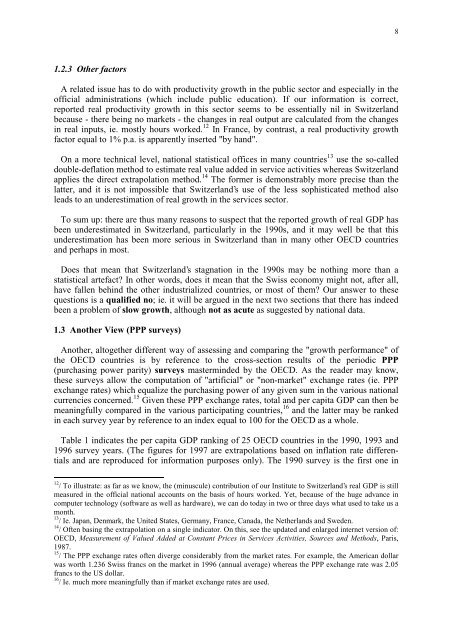Did the Swiss Economy Really Stagnate in the 1990s, and Is ...
Did the Swiss Economy Really Stagnate in the 1990s, and Is ...
Did the Swiss Economy Really Stagnate in the 1990s, and Is ...
You also want an ePaper? Increase the reach of your titles
YUMPU automatically turns print PDFs into web optimized ePapers that Google loves.
8<br />
1.2.3 O<strong>the</strong>r factors<br />
A related issue has to do with productivity growth <strong>in</strong> <strong>the</strong> public sector <strong>and</strong> especially <strong>in</strong> <strong>the</strong><br />
official adm<strong>in</strong>istrations (which <strong>in</strong>clude public education). If our <strong>in</strong>formation is correct,<br />
reported real productivity growth <strong>in</strong> this sector seems to be essentially nil <strong>in</strong> Switzerl<strong>and</strong><br />
because - <strong>the</strong>re be<strong>in</strong>g no markets - <strong>the</strong> changes <strong>in</strong> real output are calculated from <strong>the</strong> changes<br />
<strong>in</strong> real <strong>in</strong>puts, ie. mostly hours worked. 12 In France, by contrast, a real productivity growth<br />
factor equal to 1% p.a. is apparently <strong>in</strong>serted "by h<strong>and</strong>".<br />
On a more technical level, national statistical offices <strong>in</strong> many countries 13 use <strong>the</strong> so-called<br />
double-deflation method to estimate real value added <strong>in</strong> service activities whereas Switzerl<strong>and</strong><br />
applies <strong>the</strong> direct extrapolation method. 14 The former is demonstrably more precise than <strong>the</strong><br />
latter, <strong>and</strong> it is not impossible that Switzerl<strong>and</strong>’s use of <strong>the</strong> less sophisticated method also<br />
leads to an underestimation of real growth <strong>in</strong> <strong>the</strong> services sector.<br />
To sum up: <strong>the</strong>re are thus many reasons to suspect that <strong>the</strong> reported growth of real GDP has<br />
been underestimated <strong>in</strong> Switzerl<strong>and</strong>, particularly <strong>in</strong> <strong>the</strong> <strong>1990s</strong>, <strong>and</strong> it may well be that this<br />
underestimation has been more serious <strong>in</strong> Switzerl<strong>and</strong> than <strong>in</strong> many o<strong>the</strong>r OECD countries<br />
<strong>and</strong> perhaps <strong>in</strong> most.<br />
Does that mean that Switzerl<strong>and</strong>’s stagnation <strong>in</strong> <strong>the</strong> <strong>1990s</strong> may be noth<strong>in</strong>g more than a<br />
statistical artefact? In o<strong>the</strong>r words, does it mean that <strong>the</strong> <strong>Swiss</strong> economy might not, after all,<br />
have fallen beh<strong>in</strong>d <strong>the</strong> o<strong>the</strong>r <strong>in</strong>dustrialized countries, or most of <strong>the</strong>m? Our answer to <strong>the</strong>se<br />
questions is a qualified no; ie. it will be argued <strong>in</strong> <strong>the</strong> next two sections that <strong>the</strong>re has <strong>in</strong>deed<br />
been a problem of slow growth, although not as acute as suggested by national data.<br />
1.3 Ano<strong>the</strong>r View (PPP surveys)<br />
Ano<strong>the</strong>r, altoge<strong>the</strong>r different way of assess<strong>in</strong>g <strong>and</strong> compar<strong>in</strong>g <strong>the</strong> "growth performance" of<br />
<strong>the</strong> OECD countries is by reference to <strong>the</strong> cross-section results of <strong>the</strong> periodic PPP<br />
(purchas<strong>in</strong>g power parity) surveys masterm<strong>in</strong>ded by <strong>the</strong> OECD. As <strong>the</strong> reader may know,<br />
<strong>the</strong>se surveys allow <strong>the</strong> computation of "artificial" or "non-market" exchange rates (ie. PPP<br />
exchange rates) which equalize <strong>the</strong> purchas<strong>in</strong>g power of any given sum <strong>in</strong> <strong>the</strong> various national<br />
currencies concerned. 15 Given <strong>the</strong>se PPP exchange rates, total <strong>and</strong> per capita GDP can <strong>the</strong>n be<br />
mean<strong>in</strong>gfully compared <strong>in</strong> <strong>the</strong> various participat<strong>in</strong>g countries, 16 <strong>and</strong> <strong>the</strong> latter may be ranked<br />
<strong>in</strong> each survey year by reference to an <strong>in</strong>dex equal to 100 for <strong>the</strong> OECD as a whole.<br />
Table 1 <strong>in</strong>dicates <strong>the</strong> per capita GDP rank<strong>in</strong>g of 25 OECD countries <strong>in</strong> <strong>the</strong> 1990, 1993 <strong>and</strong><br />
1996 survey years. (The figures for 1997 are extrapolations based on <strong>in</strong>flation rate differentials<br />
<strong>and</strong> are reproduced for <strong>in</strong>formation purposes only). The 1990 survey is <strong>the</strong> first one <strong>in</strong><br />
12 / To illustrate: as far as we know, <strong>the</strong> (m<strong>in</strong>uscule) contribution of our Institute to Switzerl<strong>and</strong>’s real GDP is still<br />
measured <strong>in</strong> <strong>the</strong> official national accounts on <strong>the</strong> basis of hours worked. Yet, because of <strong>the</strong> huge advance <strong>in</strong><br />
computer technology (software as well as hardware), we can do today <strong>in</strong> two or three days what used to take us a<br />
month.<br />
13 / Ie. Japan, Denmark, <strong>the</strong> United States, Germany, France, Canada, <strong>the</strong> Ne<strong>the</strong>rl<strong>and</strong>s <strong>and</strong> Sweden.<br />
14 / Often bas<strong>in</strong>g <strong>the</strong> extrapolation on a s<strong>in</strong>gle <strong>in</strong>dicator. On this, see <strong>the</strong> updated <strong>and</strong> enlarged <strong>in</strong>ternet version of:<br />
OECD, Measurement of Valued Added at Constant Prices <strong>in</strong> Services Activities, Sources <strong>and</strong> Methods, Paris,<br />
1987.<br />
15 / The PPP exchange rates often diverge considerably from <strong>the</strong> market rates. For example, <strong>the</strong> American dollar<br />
was worth 1.236 <strong>Swiss</strong> francs on <strong>the</strong> market <strong>in</strong> 1996 (annual average) whereas <strong>the</strong> PPP exchange rate was 2.05<br />
francs to <strong>the</strong> US dollar.<br />
16 / Ie. much more mean<strong>in</strong>gfully than if market exchange rates are used.
















